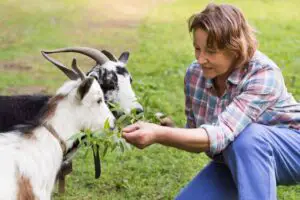Table of Contents
Goat farming is a rewarding and challenging endeavor. Among the challenges goat farmers face is dealing with the unfortunate circumstance of a goat carrying a dead kid inside her.

This can be a complex situation, requiring immediate attention and careful handling to ensure the health and well-being of the mother goat.
This comprehensive guide aims to provide you with vital information on how to recognize, prevent, handle, and recover from such a situation.
Understanding the Issue
Recognizing the Signs and Symptoms
When dealing with goats, it’s crucial to recognize the signs and symptoms of a dead kid inside. The doe may show signs of discomfort, including unease, restlessness, or unusual behavior.
She may stop eating or drinking, appear bloated, or exhibit signs of pain such as grinding her teeth or pressing her belly against hard objects.
Other indications may include foul-smelling discharge, fever, or prolonged labor without delivering a kid.
Causes of Fetal Death in Goats
Several factors can cause fetal death in goats. These include infections, nutritional deficiencies, stress, trauma, certain medications, and age-related complications.
Infections like toxoplasmosis, chlamydiosis, and Q-fever are some of the common causes.
It’s also important to note that multiple pregnancies, which are common in goats, can increase the risk of fetal death due to limited space in the womb or unequal distribution of nutrients among the fetuses.
Diagnosis and Confirmation
Veterinary Consultation
If you suspect that a goat has a dead kid inside, it’s crucial to consult a veterinarian immediately. They can conduct a thorough examination and recommend further diagnostic procedures if necessary.
Use of Ultrasound and Other Diagnostic Tools
Ultrasound is a common diagnostic tool used to confirm the presence of a dead fetus in goats.
Other diagnostic procedures may include blood tests, urine tests, and radiographs, depending on the situation and the veterinarian’s recommendation.
Handling the Situation
Immediate Steps to Take
- Isolate the Doe: The first step is to carefully isolate the affected doe from the rest of the herd. This is to prevent any potential spread of infection and to provide a quiet, stress-free environment for her. Make sure she is comfortable and has access to fresh water and food.
- Call the Veterinarian: As soon as you have isolated the doe, call your veterinarian. Brief them on the situation and follow their immediate advice. They may guide you on further steps to take while waiting for their arrival or before you can get the goat to the clinic.
- Monitor Vital Signs: It’s important to monitor the doe’s vital signs while awaiting the vet’s arrival. Look for changes in body temperature, heart rate, and respiratory rate. A fever could indicate an infection, while rapid breathing or heart rate could signal distress or pain.
- Ensure Hydration and Nutrition: Even if the doe doesn’t feel like eating, it’s important to make sure she stays hydrated. Encourage her to drink water. If she’s not interested in her regular feed, try offering her favorite treats or some fresh greens.
- Observe Behavior: Keep a close watch on the doe’s behavior. Signs of discomfort include restlessness, teeth grinding, pressing her belly against hard objects, or excessive bleating. Any drastic changes in behavior should be reported to the vet.
- Prepare for Vet’s Arrival: Depending on the severity of the situation, the vet might need to perform an emergency procedure on-site. Prepare your space by ensuring good lighting and accessibility. If possible, clean the doe, particularly her rear area.
- Protect Yourself: Remember to protect yourself and others who may assist. Wear protective clothing, including gloves, and wash hands thoroughly before and after handling the doe. This can help prevent the spread of any potential infections.
Remember, these steps are general guidelines. Always follow the advice of your veterinarian as they will provide instructions based on the specific condition and needs of your goat.
Ensuring the Mother Goat’s Health

The health and well-being of the mother goat are paramount during this time. Make sure she has access to clean water at all times.
Dehydration can worsen her condition, so it’s important to encourage her to drink.
In terms of nutrition, she may not have an appetite, but try to provide easy-to-digest feed. Fresh greens, hay, and specially formulated goat feed can help keep her strength up.
Monitor her behavior closely. Changes in behavior can indicate pain or distress. Look for signs such as restlessness, teeth grinding, excessive bleating, or other unusual behaviors.
While it’s important to comfort the doe, also remember to protect yourself.
Wear gloves when handling her or her bedding, and wash your hands thoroughly afterward to prevent any potential transmission of disease.
Once your veterinarian arrives, they will conduct a thorough examination, confirm the diagnosis, and recommend the best course of action.
This could involve medicinal treatment, manual removal of the dead kid, or surgical intervention in more complex cases.
It’s important to follow your vet’s instructions carefully.
Post-care after the removal of the dead kid will involve keeping the doe warm, ensuring she continues to eat and drink, and monitoring for any signs of infection or other complications.
Every situation is unique. What works for one goat may not work for another. Always consult with a professional to ensure the best possible outcome for your doe.
Medical Interventions
Surgical Options
In some cases, surgical intervention may be necessary to remove the dead fetus. This is typically considered when the fetus cannot be removed naturally or with the help of medication.
Medicinal Treatments
Medicinal treatments may also be an option, depending on the situation. These can include antibiotics to prevent infection, pain relief medication, and drugs to induce labor or contract the uterus.
Post-Care of the Mother Goat
Physical Recovery
After the ordeal, the mother goat will need time to recover physically. This includes proper wound care if surgery was performed, a balanced diet to replenish lost nutrients, and rest.
Mental Health and Behavior
The mental well-being of the goat is equally important. Some does may show signs of depression or behavioral changes after losing a kid.
Providing a nurturing, comfortable environment and plenty of attention can help them recover mentally.
Preventive Measures

Importance of Regular Health Checks
Regular health checks are essential in preventing fetal deaths in goats. This involves periodic veterinary visits, vaccinations, deworming, and ensuring that the goats are in a clean, stress-free environment.
Regular check-ups allow for early detection of any potential issues and timely intervention to prevent complications.
Role of Balanced Nutrition
Proper nutrition plays a critical role in the health of pregnant goats and their kids.
Ensuring a balanced diet rich in essential vitamins, minerals, and other nutrients can significantly reduce the risk of complications during pregnancy and childbirth.
Long-Term Health Management
Regular Veterinary Follow-ups
Following the incident, regular veterinary follow-ups are crucial to monitor the goat’s recovery and prevent future complications.
These visits can help detect any potential issues early and ensure the goat stays healthy.
Adjustments to Diet and Lifestyle
Finally, adjustments may be needed in the goat’s diet and lifestyle after such an incident.
This could involve increased nutritional intake, changes in living conditions, or modifications to the breeding plan.
These adjustments are best made in consultation with a veterinarian or a professional goat breeder.
Conclusion
Dealing with a goat carrying a dead kid inside can be emotionally taxing and physically demanding.
However, with the right knowledge, timely intervention, and proper care, the health and well-being of the mother goat can be preserved.
It’s important that goat farmers are prepared for such situations, know the signs to look for, and understand the steps to take should they occur.
By staying informed and vigilant, we can ensure the welfare of our goats and the overall success of our farms.






![How To Build A Four-Season Room On A Deck [Guide] How To Build A Four-Season Room On A Deck [Guide]](https://homesteadandprepper.com/wp-content/uploads/2021/04/How-to-build-a-four-season-room-on-a-deck-150x150.jpg)


![How To Fix Gap Between Door And Floor [Guide] How To Fix Gap Between Door And Floor [Guide]](https://homesteadandprepper.com/wp-content/uploads/2021/09/How-to-Fix-Gap-between-Door-and-Floor-150x150.jpg)